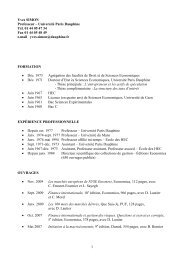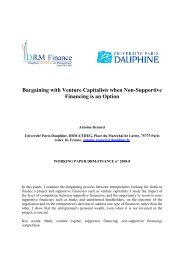Internal versus External growth: impact on operational and ... - CEREG
Internal versus External growth: impact on operational and ... - CEREG
Internal versus External growth: impact on operational and ... - CEREG
Create successful ePaper yourself
Turn your PDF publications into a flip-book with our unique Google optimized e-Paper software.
Finally, we cumulate our internal <strong>and</strong> external <str<strong>on</strong>g>growth</str<strong>on</strong>g> measures, <strong>and</strong> we estimate which<br />
<str<strong>on</strong>g>growth</str<strong>on</strong>g> strategy performed better, by regressing the abnormal mean returns of this equati<strong>on</strong> <strong>on</strong><br />
the cumulated internal <strong>and</strong> external <str<strong>on</strong>g>growth</str<strong>on</strong>g> rates (CGi <strong>and</strong> CGx):<br />
a j,t = γ 0 + γ 1 CGi j,t + γ 2 CGx j,t + ε j,t (9)<br />
3.4. Research design for operati<strong>on</strong>al performance<br />
We use cash flows measures in order to assess the operati<strong>on</strong>al performance of the firms.<br />
Those measures have two advantages compared to other st<strong>and</strong>ard accounting measures: they<br />
moderate the <str<strong>on</strong>g>impact</str<strong>on</strong>g> of the financing of the acquisiti<strong>on</strong> (cash, stock or mixed) <strong>and</strong> the <str<strong>on</strong>g>impact</str<strong>on</strong>g><br />
of the method of accounting for the transacti<strong>on</strong> (purchase or pooling accounting) as<br />
menti<strong>on</strong>ed by Healy et al. (1992). Operating cash flows are defined as sales, minus the cost of<br />
good sold, <strong>and</strong> selling <strong>and</strong> administrative expenses, plus depreciati<strong>on</strong> <strong>and</strong> goodwill expenses.<br />
The cash flows are then deflated by the firm’s total assets or sales to obtain a comparable<br />
metric. We prefer not to use the market value of assets as a deflator because a post-acquisiti<strong>on</strong><br />
increase (or decline) in market value will decrease (increase) cash flow ratios even if the<br />
operating cash flows stay steady.<br />
Because cash flows variables are affected by firm-specific <strong>and</strong> industry-wide factors, we<br />
adjust them using industry performance as a benchmark, by subtracting every year the<br />
industry median from the firm value. However, acquiring firms usually undertake acquisiti<strong>on</strong>s<br />
when they are bigger than industry-median firms (Ghosh, 2001) <strong>and</strong> following a period of<br />
superior performance (Morck et al., 1990). Therefore, firms are also matched as in Loughran<br />
<strong>and</strong> Ritter (1997) <strong>and</strong> Ghosh (2001) with the following method: all firms from the industry of<br />
our sample’s companies with total assets between 25% <strong>and</strong> 200% are ranked by their<br />
operating cash flows, <strong>and</strong> we select the firms whose cash flows are the closest of our sample’s<br />
companies.<br />
15


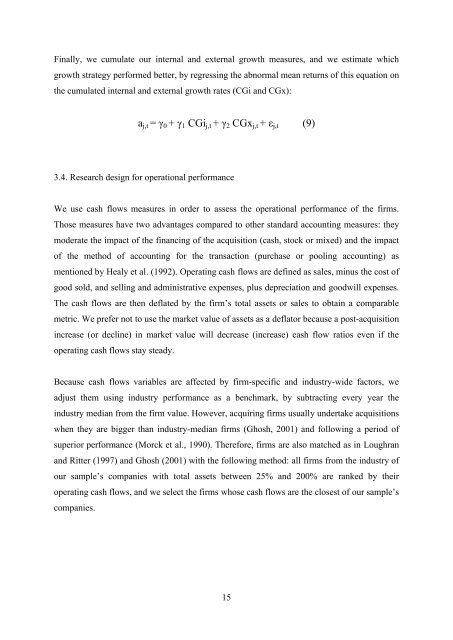
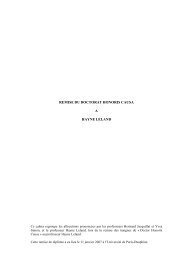

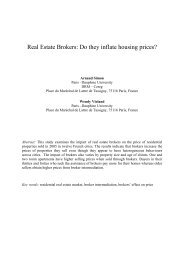
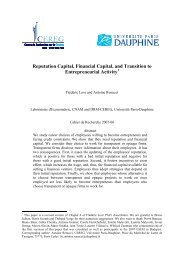

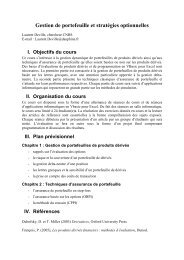


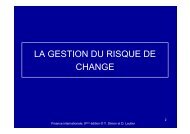
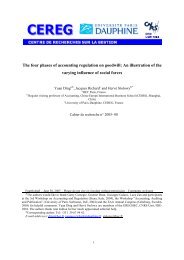
![& 6 ] ^ F ]^ - CEREG - Université Paris-Dauphine](https://img.yumpu.com/33326502/1/184x260/-6-f-cereg-universitac-paris-dauphine.jpg?quality=85)

